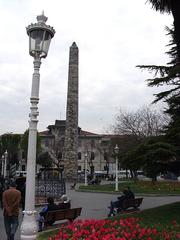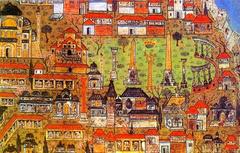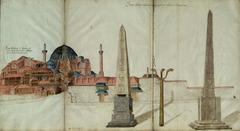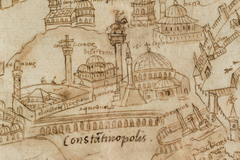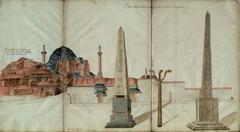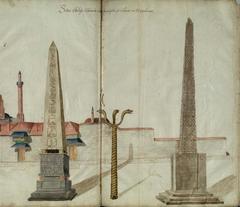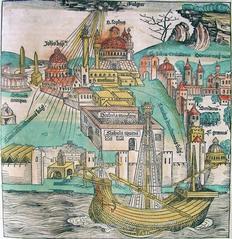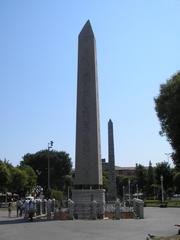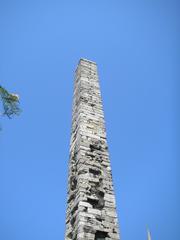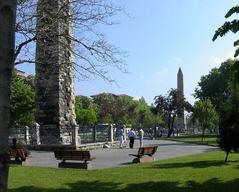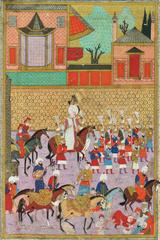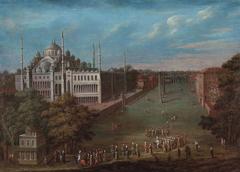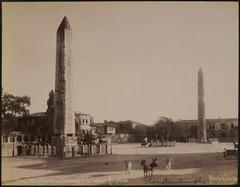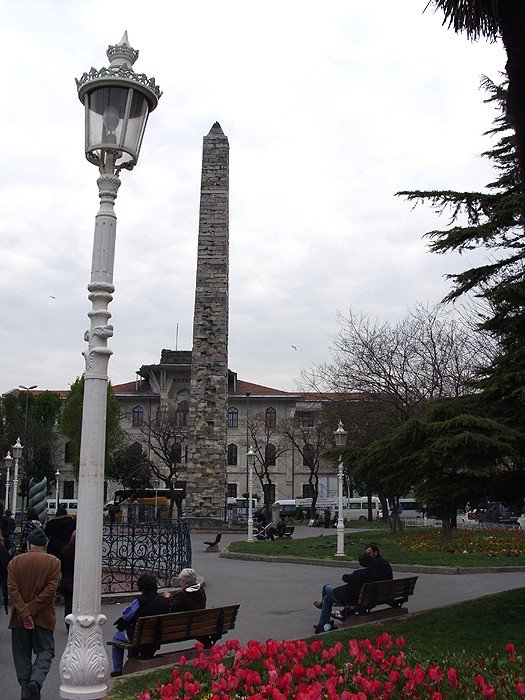
Walled Obelisk Istanbul: Visiting Hours, Tickets, and Historical Significance
Date: 14/06/2025
Introduction
Nestled at the heart of Istanbul’s historic Sultanahmet Square, the Walled Obelisk (Turkish: Örme Dikilitaş) stands as a resilient monument to the city’s Byzantine legacy and its centuries-old role as a bridge between empires and cultures. Constructed primarily in the 10th century CE under Emperor Constantine VII Porphyrogenitus, this stone column once gleamed with gilded bronze plaques celebrating imperial triumphs. Though stripped of its ornamentation during the Fourth Crusade, the Walled Obelisk’s weathered limestone core remains a powerful symbol of Constantinople’s grandeur, public spectacle, and rich historical tapestry. This guide offers a detailed overview of its origins, architectural features, cultural significance, and essential visitor information to help you explore one of Istanbul’s most captivating historical sites (Property Turkey, Iyi Turkey, Istanbul Tourism).
Table of Contents
- Origins and Construction
- Architectural Features
- Historical Significance
- The Walled Obelisk Through Time
- Restoration and Preservation
- Visiting Information
- Travel Tips
- Nearby Attractions
- FAQ
- Conclusion
- Sources
Origins and Construction
The Walled Obelisk was built during the reign of Emperor Constantine VII Porphyrogenitus (r. 913–959 CE), although some historical accounts suggest its core may date back to the 4th century (Iyi Turkey). Erected on the central spina of the Hippodrome of Constantinople—then the social and ceremonial heart of the city—the monument was constructed from rough-cut limestone blocks and originally rose to a height of about 32 meters (105 feet).
Unlike the nearby Egyptian Obelisk, which was quarried in Luxor and covered in hieroglyphs, the Walled Obelisk was assembled locally and, at its peak, was lavishly clad in gilded bronze plates that depicted Byzantine military victories and imperial events. These plates not only reflected imperial propaganda but also enhanced the monument’s visual dominance within the Hippodrome (Property Turkey).
Architectural Features
- Materials: The obelisk is built from large, roughly hewn limestone blocks. Its surface is now bare, but historical records confirm it was once sheathed in bronze.
- Dimensions: Originally about 32 meters tall, the obelisk currently stands at approximately 20 meters (66 feet) after the loss of its upper sections.
- Design: The monument tapers upward from a square base, consistent with Roman and Byzantine columnar styles. Unlike its Egyptian counterpart, it lacks inscriptions or hieroglyphics; any original imperial inscriptions were likely on the now-lost bronze plaques.
- Setting: Positioned on the Hippodrome’s spina, the Walled Obelisk formed part of a ceremonial axis with the Obelisk of Theodosius and the Serpent Column, visually uniting multiple eras of monumental art.
Historical Significance
The Walled Obelisk not only decorated the Hippodrome but also served as a potent symbol of imperial power. Its gilded surfaces and prominent location reinforced the legitimacy and glory of the Byzantine emperors. The Hippodrome itself was the stage for public celebrations, political events, and historic crises—such as the Nika Riots of 532 CE—making the obelisk a silent witness to centuries of dramatic urban life (Iyi Turkey).
After the Ottoman conquest in 1453, while the Hippodrome’s original function faded, the obelisk remained a familiar landmark in what became known as At Meydanı (Horse Square). Despite neglect and earthquake damage, it survived as a tangible link to the city’s Byzantine and Roman past.
Restoration and Preservation
The Walled Obelisk suffered significant losses over time, most notably the removal of its bronze plaques during the Fourth Crusade in 1204. In modern times, Turkish authorities have prioritized its conservation, with stabilization and maintenance work ensuring its survival as part of the Sultanahmet Archaeological Park—a UNESCO World Heritage Site (UNESCO World Heritage). Informational signage and educational programs have been introduced to enhance public awareness and appreciation (Istanbul Archaeology Museums).
Visiting Information
Location: Southern end of Sultanahmet Square, Istanbul’s Old City, easily reached by foot or public transport.
How to Get There:
- Tram: Take the T1 tram line to Sultanahmet Station; the obelisk is a 5-minute walk away (Istanbul.com).
- Ferry: From Kadıköy or Üsküdar, take a ferry to Eminönü, then tram T1.
- Taxi and Walking: Taxis are available but often delayed by traffic; walking is convenient if staying in the area.
Visiting Hours: Sultanahmet Square is open 24/7, allowing visitors to experience the obelisk at any time (Istanbul Tips).
Admission: There is no entrance fee; the monument is freely accessible at all hours (Istanbul.com).
Accessibility: The square is flat and paved, suitable for wheelchairs and strollers. Information is available in Turkish and English.
Travel Tips
- Best Visiting Time: Early mornings or late afternoons offer pleasant lighting for photography and fewer crowds.
- Dress Code: Modest clothing is recommended if combining your visit with nearby mosques.
- Safety: The area is safe but busy; keep personal belongings secure and be cautious of common tourist scams.
- Amenities: Public restrooms (with a small fee), nearby cafes, souvenir stalls, and tourist information booths are available.
- Photography: Capture the obelisk with the Blue Mosque or Hagia Sophia in the background for iconic shots.
Nearby Attractions
- Obelisk of Theodosius: Ancient Egyptian obelisk with hieroglyphs, also on the Hippodrome spina.
- Serpent Column: Bronze monument from ancient Greece.
- Blue Mosque: World-renowned for its architecture and blue tiles.
- Hagia Sophia: Iconic former basilica-mosque-museum.
- Basilica Cistern: Atmospheric underground water reservoir.
All are within a short stroll, making the area ideal for a half-day or full-day historical tour (Istanbul Travel Blog).
Frequently Asked Questions (FAQ)
Q: Are tickets required to visit the Walled Obelisk?
A: No, the monument and Sultanahmet Square are open to the public free of charge.
Q: What are the visiting hours?
A: The obelisk and square are accessible 24 hours a day, year-round.
Q: Is the Walled Obelisk wheelchair accessible?
A: Yes, the square is paved and flat, though some cobblestone areas may require caution.
Q: Can I hire a guide?
A: Yes, private guides are available, and some city passes include Hippodrome tours.
Q: What’s the best time for photography?
A: Early morning or late afternoon provides the best natural light and fewer visitors.
Conclusion
The Walled Obelisk is more than a relic of stone; it is a living witness to the grandeur, conflict, and continuity of Istanbul’s history. Its free and constant accessibility, location amidst other legendary monuments, and enduring architectural presence make it an essential stop for any visitor seeking to understand this city’s layered past. Whether you are drawn by its history, architectural curiosity, or the vibrant atmosphere of Sultanahmet Square, be sure to include the Walled Obelisk in your Istanbul itinerary.
For the latest updates, insider tips, and guided experiences, download the Audiala app and follow us on social media. Take the time to explore the surrounding landmarks to fully immerse yourself in the living history of Istanbul.
Sources and Further Reading
- Sultanahmet and the Old City of Istanbul: From Past to Present – Property Turkey
- Walled Obelisk Istanbul: History, Visiting Hours, Tickets, and Travel Tips – Istanbul Tourism
- Hippodrome of Constantinople Sultanahmet Square – Iyi Turkey
- Hippodrome of Constantinople – Istanbul.com
- UNESCO World Heritage Site - Sultanahmet
- Istanbul Archaeology Museums
- Sultanahmet Square – Istanbul Travel Blog
- Tips for Visiting Sultanahmet Square – Istanbul Tips
Enhance your Istanbul travel experience:
- Download the Audiala app for audio tours and exclusive travel guides.
- Follow us on social media for real-time updates and cultural insights.
- Explore related posts about Istanbul’s historical highlights and travel tips on our website.
Suggested Visuals and Media:
- High-quality images of the Walled Obelisk with alt text such as “Walled Obelisk in Sultanahmet Square, Istanbul.”
- Interactive map pinpointing the Walled Obelisk, Blue Mosque, and Hagia Sophia.
